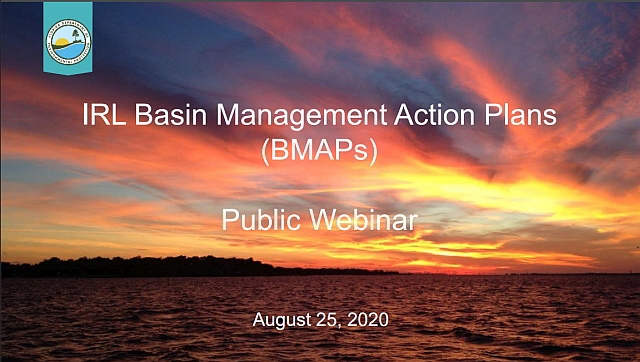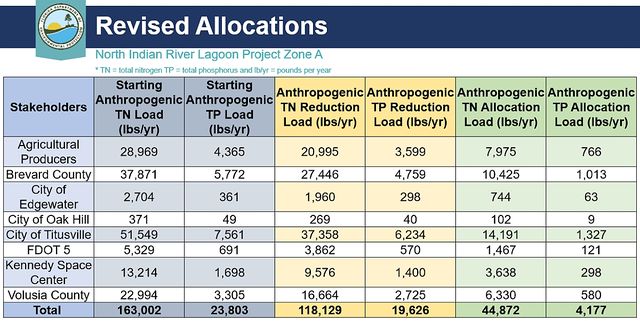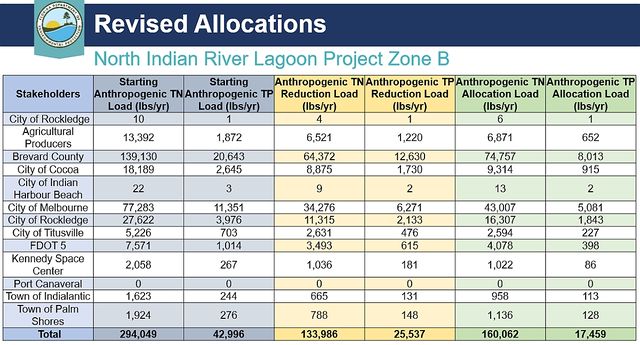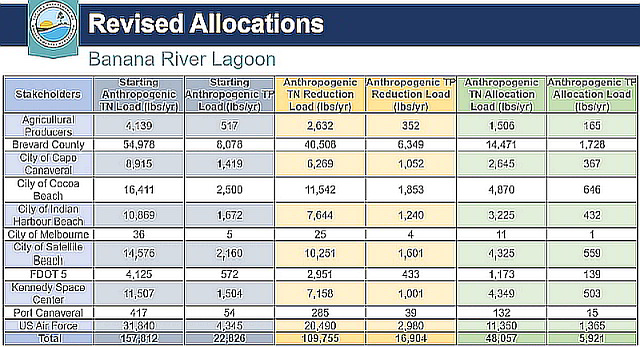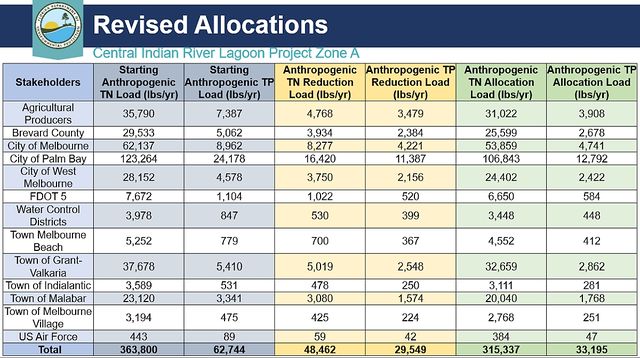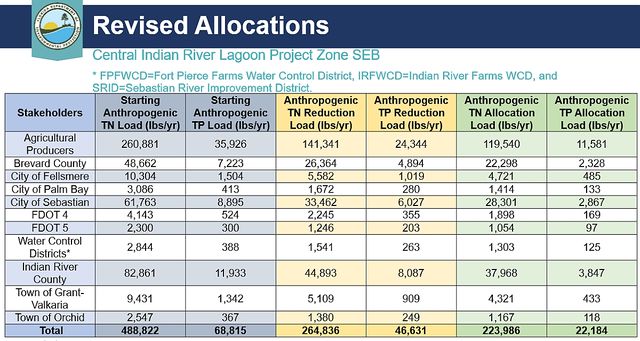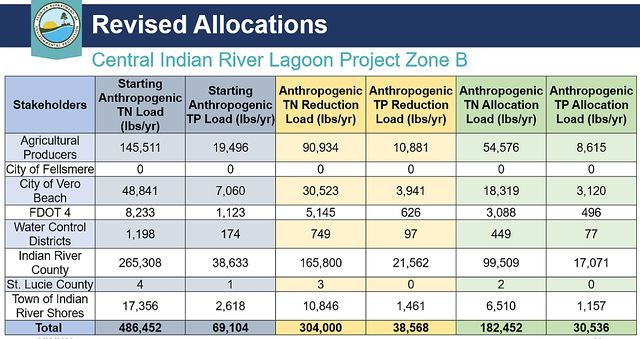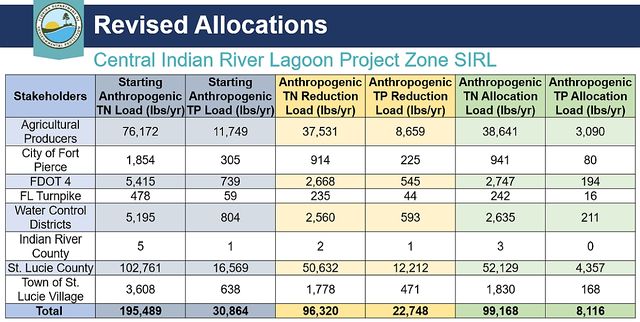IRLNews:2020/09/23/Florida DEP Proposes New Nitrogen and Phosphorus Allocations for IRL
Considering seagrass to be the primary keystone species indicating the health of the Indian River Lagoon, the DEP has determined the amount of Anthropogenic (human-introduced) Nitrogen and Phosphorus the national estuary's lagoons can receive, and still promote seagrass growth. The updated BMAP, last revised in 2013, would ask IRL communities to meet the suggested allocation goals by the year 2030.
Stacy Cecil, BMAP Coordinator for the North Indian River and Banana River Lagoons, presented "Overview of Revised Allocations" to explain how the new allocation figures were determined. Ms. Cecil's presentation can be viewed on the Department of Environmental Protection 2020 Indian River Lagoon Basin Management Action Plan Public Webinar video starting at 1:15:50.
The DEP has made all of the meeting's documents available at http://publicfiles.dep.state.fl.us/DEAR/BMAP/IndianRiverLagoon/Meetings/Lagoon-wide/2020_08_Update/ including individual Allocation Charts for almost all Indian River Lagoon communities.
Current Anthropogenic Nitrogen and Phosphorus Totals
Currently, the Indian River Lagoon's total human-introduced Nitrogen load is 2,149,426 lbs/yr and the total Phosphorus load is 321,152 lbs/yr.
| Starting Nitrogen and Phosphorus Loads* | ||
|---|---|---|
| Location | Nitrogen | Phosphorus |
| North IRL A | 163,002 | 23,803 |
| North IRL B | 294,049 | 42,996 |
| Banana River | 157,812 | 22,826 |
| Central IRL A | 363,800 | 62,744 |
| Central IRL SEB | 488,822 | 68,815 |
| Central IRL B | 486,452 | 69,104 |
| Central IRL SIRL | 195,489 | 30,864 |
| IRL Total N & P Load (lbs/yr) | 2,149,426 | 321,152 |
*Data from the DEP revised allocation charts below
2020 Revised Nitrogen and Phosphorus Allocation Charts
- TN= Total Nitrogen and TP= Total Phosphorus
- Starting Anthropogenic TN Load - The amount of human-introduced nitrogen currently in the water.
- Anthropogenic TN Reduction Load - The Nitrogen reduction needed to meet the proposed allocation.
- Anthropogenic TN Allocation Load - The amount of Nitrogen allowed.
- Click a chart to enlarge.
North Indian River Lagoon Project Zone A
The City of Titusville with a starting Total Nitrogen (TN) load of 51,549 lbs/yr needs a Reduction of 37,358 lbs/yr to meet the proposed Allocation of 14,191 lbs/year. A 72% (37,358/51,549 = .724) Nitrogen reduction is required.
North Indian River Lagoon Project Zone B
Brevard County has a starting TN of 139,130 and needs a Reduction of 64,372 to meet it's Allocation of 74,757 lbs/yr. 64,372/139,130 = .462 or 46% Nitrogen Reduction required.
Banana River Lagoon
Brevard County with a 54,978 lbs/yr TN starting load needs a 40,508 lbs/yr Reduction to meet it's Allocation goal of 14,471 lbs/yr. A 74% Total Nitrogen reduction is required.
Central Indian River Lagoon Project Zone A
The City of Palm Bay with a Starting Nitrogen load of 123,264 lbs/yr needs a 16,420 lbs/yr Nitrogen Reduction to meet it's Allocation goal of 106,843 lbs/yr. A 13% Total Nitrogen Reduction is required.
Central Indian River Lagoon Project Zone Sebastian
Agriculture near Sebastian currently adds 260,881 pounds of Nitrogen per year to the IRL near Sebastian, and would need a 141,341 lb Reduction to meet it's 119,540 lbs/yr Nitrogen Allocation. A 55% Nitrogen reduction is required.
Agriculture currently adds 35,926 lbs/yr of Phosphorus and would need a 24,344 lb/yr Reduction to meet its allocated goal of 11,581 pounds per year. A 68% Phosphorus Reduction is required.
Central Indian River Lagoon Project Zone B
Indian River County has a 265,308 lbs/yr Starting Nitrogen Load and needs a 165,800 lbs/yr Reduction to meet it's 99,509 lbs/yr Nitrogen Allocation. A 62% Nitrogen reduction is required.
Central Indian River Lagoon Project Zone SIRL
St. Lucie County currently adds 102,761 lbs/yr of Nitrogen to the IRL and would need a Reduction of 50,632 lbs/yr to meet the 52,129 lbs/yr Allocation. A 49% Nitrogen reduction is required.
Questions and Answers
Question: Do any of the panelists think any subsegment shows any significant seagrass recovery in the Segment B portion of the North Indian River?
Answer: The seagrass analysis for 2020 is still an ongoing process. Once the results of the analysis are released in December, DEP can determine any significant seagrass recovery or need for improvement. There will be more information pertaining to this analysis at another public meeting tentatively scheduled in the next few months. Also, the water management districts’ 2019 seagrass maps showed the lagoon reaching 42 % of the maximum seagrass extent recorded in 2007.
Question: How does the "muck" distribution throughout the IRL affect the seagrass expansion?
Answer: Muck is an important contributor for the inability of seagrass regrowth. DEP has a specific policy to credit the removal of muck from the Indian River Lagoon. There have already been efforts made to remove muck from the bottom of the lagoon. Muck inhibits habitat expansion as well as contributes nutrients to the water column through a process called fluxing. DEP is looking at muck as a potential source of significant nutrient loading. However, removing muck is only a temporary fix for some areas since there is a continuous supply of muck coming from the watershed. A goal would be to have significant watershed efforts to prevent new muck and future issues. DEP credits muck removal on a provisional basis in its credit guidance policy developed for IRL BMAPs. Some items that need to be present for muck removal to be credited include control measures that already exist to prevent excessive muck accumulation. An entity may lose credits if muck continues to accumulate.
Question: Do the use of gasoline equipped boats/vessels impact seagrass health?
Answer: When a mechanical vessel propels through a seagrass bed, this can potentially disturb or destroy seagrasses creating less viable seagrasses to measure. However, the number of destructive events caused by vessels to seagrass beds cannot be determined accurately or related to nutrient loading and total maximum daily loads (TMDLs). There are not a lot of data available on how to trace hydrocarbons, like gasoline or oil from motorized engines, impact seagrass health. It may be a good research topic to suggest to one of the academic institutions in the area to help build that body of understanding.
Question: Have there been any improvements in water quality in the IRL since BMAP implementation?
Answer: The second part of the meeting today will show the results of water quality data collected and analyzed by the (St. Johns River) water management district. The beginning of 2020 has been relatively dry up until the start of the rainy season. The district noted some improvements in water quality in that dry period. Although for the Indian River Lagoon, it is too early to tell if there is a correlation between nutrient loading varying from year to year due to precipitation.
Question: How will compliance be achieved for TMDL's?
Answer: The compliance for the IRL BMAPs is based on seagrass evaluation results done every two years. DEP is using the two-step evaluation process as mentioned at the beginning of this webinar. To meet seagrass regrowth requirements, required reductions are included in the TMDL rule language to get to the necessary water quality conditions for restoring historic seagrass depth limits within each BMAP. Compliance is met through meeting those conditions and results.
Question: What if we all achieve our required reductions, but the seagrass does not come back?
Answer: This question is asked a lot since we are estimating project and load reduction benefits to the environment. A lot of the numbers are not exact because we use estimates. In the monitoring section of the BMAP, we include a lot of research priorities—on which we recently asked for feedback—so that we focus state resources on the right kind of work and we have information to better understand why seagrasses occur in the IRL the way that they do. If we see a lot of nutrient reductions but without seagrass recovery, we can adapt based on the research results. It is a matter of continuing to work and learn about how seagrass responds. On top of that, things change with weather and climate too and we have to consider those changes as well. There is a lot of work by the SJRWMD and other folks on the dynamics of the IRL; it is a complex system. Overall, the research priorities and the adaptive management process are how we handle unexpected responses of seagrass.
Question: What happens if the TMDL allocations are not met for seagrass health?
Answer: The BMAPs will continue until the TMDLs are met. The adaptive management process plays into that, and the state will continue to focus efforts (staff resources, funding, research, etc.) to address the underlying reasons why the seagrass is not recovering. This is one reason why the BMAP monitoring sections include research priorities, and these are intended to feed adaptive management for this complex system so that we're spending resources wisely.
Question: How do we access the allocation charts shown in the presentation today?
Answer: These charts will go on the PDF along with the recording of today’s webinar on the FTP site for the DEP publicly accessible files. The breakdown of each individual stakeholder’s allocation and other calculation methodology will be on the FTP site as well within the video recording of this webinar. DEP FTP SERVER

